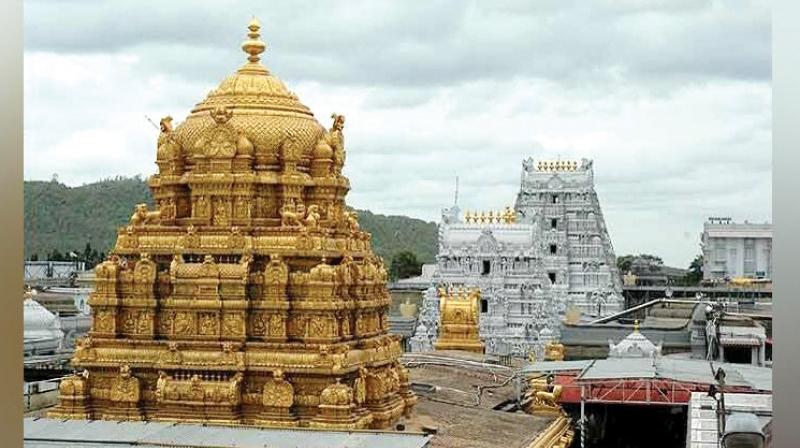TTD to introduce facial recognition at Tirupati temple


Venkateswara Temple, Tirumala.
Tirupati: In a move aimed at obviating misuse of temple services, the Tirumala Tirupati Devasthanams (TTD) is introducing facial recognition technology at the world famous Lord Venkateswara shrine here.
The new tech will be experimented at sarva darshanam, tokenless darshan (holy visit), laddu disbursal, accommodation allotment systems, caution deposit refunds and others by TTD, the official custodian of the hill shrine which the devotees throng all through the year.
“TTD is set to introduce facial recognition technology on an experimental basis at Vaikuntam 2 and AMS systems from March 1 onwards,” said a temple official.
As part of this new initiative, D Narasimha Kishore, chief vigilance and security officer (CVSO), TTD said each and every pilgrim will be photographed at the entry point while enrolling for darshan to be matched with the data bank for averting impersonation and services misuse.
Following the first visit, that particular pilgrim can be easily identified during every subsequent visit.
“When he (pilgrim) enters the temple a second time, the man will be cross-checked with facial recognition. When he stands before the camera and his image is captured, it will be sent to the data (bank) and compared if the same ticket is matched, then he will be allowed. Else it will attract (charges of) impersonation,” Kishore said.
Other complementary benefits include tracing a missing person’s trail in the temple complex, ensuring laddus (consecrated sweets served as prasadam) delivery is not misused, ending impersonation, swift verification of devotees and others.
“Checking a devotee will be very fast. Earlier, we used to check with Aadhaar cards, take personal details manually and enter. Now even impersonation status will be stored action will be initiated, there is a proof. This is a big achievement if it succeeds hundred per cent,” said the senior Indian Police Service (IPS) officer.
On successful incorporation of this technology, once a pilgrim enters Tirumala, he is under the digital fence of the temple management. All 3,000 cameras can capture all the devotees.
“Once his (devotee) face is recognised at the time of enrollment, you can check the person at the entry point. Next when he is going to darshan. One token of prasadam will be given. There he can be checked. From there he goes to the prasadam, there also we can cross check,” he noted.
The outsourced staff manning the laddu counters are known for misusing the disbursal process, doling out excess laddus to some, which can now be sanitised with facial recognition.
Sandeep from the TTD’s IT wing pointed out that the new technology will allot accommodation only after correctly matching a pilgrim to the temple’s database.
“Even if an Aadhaar card is manipulated, facial recognition will negate those illegal efforts. We have already tested it at sarvadarshanam, it is working fine. We will also test it for accommodation for a month and half,” said Sandeep.
Following the testing phase of about 45 days at the accommodation system, Sandeep said TTD will entirely do away with the SMS service and usher in direct facial recognition.
“From then on it will be direct facial tech. We can easily identify malpractices in our system. At laddus, sarvadarshanam, accommodation ,” he asserted.
Technology may come and go but devotees of the deity have their own reflections. M Srinivasa Chary, a goldsmith from Kamareddy in Telangana observed that families consisting of young children and aged individuals should not be inconvenienced with facial recognition.
“Many pilgrims visit with all their family members and not every one of them can stand in those queues for long. If one able person from a family is allowed to take the entire rightful laddu quota of his family, then it will be good,” Chary pointed out. Chary makes sure he visits the temple at least once in a couple of months.
Likewise, Kishore observed facial recognition technology is not yet fully embraced in India, which is true when compared to China, a country widely criticised for turning into a surveillance state by misusing this technology.
“If you see the airports (in India), still they are not using facial recognition. Still they are asking for a boarding pass. Though SEBI is using the tech to some extent, many places in India, be it the government sector, are not using facial recognition,” said Kishore, adding the technology is not used even in Parliament.
According to the senior police official, biometric identification using iris and fingerprints are 100 per cent foolproof as facial recognition sometimes is only 60 percent correct.
After gauging the efficiency, TTD’s chief security officer feels that it can also be integrated into the surveillance camera command control system of one of the richest Hindu temples, which draws nearly 1 lakh visitors a day.
Meanwhile, Sandeep assured that the data harvested and mapped for facial recognition is immune to external interference, considering its secured nature in TTD’s local data centre.
“It is stored in our data centre only. It is not stored outside TTD premises. Second thing is it is an intranet application. It is not an internet application, he said.
Moreover, TTD’s data centre is fortified with a disaster recovery facility located at Tirumala Arjitham office. He claimed the public or the outside world cannot access this data.







